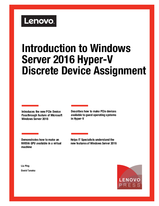Authors
Updated
18 Apr 2017Form Number
LP0088PDF size
19 pages, 114 KBAbstract
This paper describes the steps on how to enable Discrete Device Assignment (also known as PCI Passthrough) available as part of the Hyper-V role in Microsoft Windows Server 2016.
Discrete Device Assignment is a performance enhancement that allows a specific physical PCI device to be directly controlled by a guest VM running on the Hyper-V instance. Specifically, this new feature aims to deliver a certain type of PCI device class, such as Graphics Processing Units (GPU) or Non-Volatile Memory express (NVMe) devices, to a Windows Server 2016 virtual machine, where the VM will be given full and direct access to the physical PCIe device.
In this paper we describe how to enable and use this feature on Lenovo servers using Windows Server 2016 Technical Preview 4 (TP4). We provide the step-by-step instructions on how to make an NVIDIA GPU available to a Hyper-V virtual machine.
This paper is aimed at IT specialists and IT managers wanting to understand more about the new features of Windows Server 2016 and is part of a series of technical papers on the new operating system.
Table of Contents
Introduction
Installing the GPU and creating a VM
Enabling the device inside the VM
Restoring the device to the host system
Summary
Change History
Changes in the April 18 update:
- Corrections to step 3 and step 4 in "Restoring the device to the host system" on page 12.
Related product families
Product families related to this document are the following:

